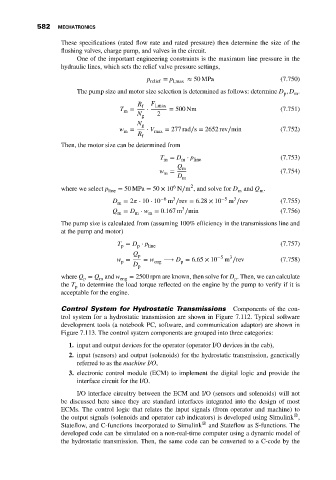Page 596 - Mechatronics with Experiments
P. 596
JWST499-Cetinkunt
JWST499-c07
582 MECHATRONICS Printer: Yet to Come October 9, 2014 8:41 254mm×178mm
These specifications (rated flow rate and rated pressure) then determine the size of the
flushing valves, charge pump, and valves in the circuit.
One of the important engineering constraints is the maximum line pressure in the
hydraulic lines, which sets the relief valve pressure settings,
p relief = p l,max ≈ 50 MPa (7.750)
The pump size and motor size selection is determined as follows: determine D , D .
p
m
R f F l,max
T = ⋅ = 500 Nm (7.751)
m
N g 2
N g
w = ⋅ V max = 277 rad∕s = 2652 rev∕min (7.752)
m
R f
Then, the motor size can be determined from
T = D ⋅ p (7.753)
m m line
Q m
w = (7.754)
m
D m
6
2
where we select p line = 50 MPa = 50 × 10 N∕m , and solve for D and Q .
m
m
3
3
D = 2 ⋅ 10 ⋅ 10 −6 m ∕rev = 6.28 × 10 −5 m ∕rev (7.755)
m
3
Q = D ⋅ w = 0.167 m ∕min (7.756)
m m m
The pump size is calculated from (assuming 100% efficiency in the transmissions line and
at the pump and motor)
T = D ⋅ p line (7.757)
p
p
Q p
3
w = = w ⟶ D = 6.65 × 10 −5 m ∕rev (7.758)
p eng p
D
p
where Q = Q and w eng = 2500 rpm are known, then solve for D . Then, we can calculate
p
m
p
the T to determine the load torque reflected on the engine by the pump to verify if it is
p
acceptable for the engine.
Control System for Hydrostatic Transmissions Components of the con-
trol system for a hydrostatic transmission are shown in Figure 7.112. Typical software
development tools (a notebook PC, software, and communication adaptor) are shown in
Figure 7.113. The control system components are grouped into three categories:
1. input and output devices for the operator (operator I/O devices in the cab),
2. input (sensors) and output (solenoids) for the hydrostatic transmission, generically
referred to as the machine I/O,
3. electronic control module (ECM) to implement the digital logic and provide the
interface circuit for the I/O.
I/O interface circuitry between the ECM and I/O (sensors and solenoids) will not
be discussed here since they are standard interfaces integrated into the design of most
ECMs. The control logic that relates the input signals (from operator and machine) to
®
the output signals (solenoids and operator cab indicators) is developed using Simulink ,
Stateflow, and C-functions incorporated to Simulink ® and Stateflow as S-functions. The
developed code can be simulated on a non-real-time computer using a dynamic model of
the hydrostatic transmission. Then, the same code can be converted to a C-code by the

